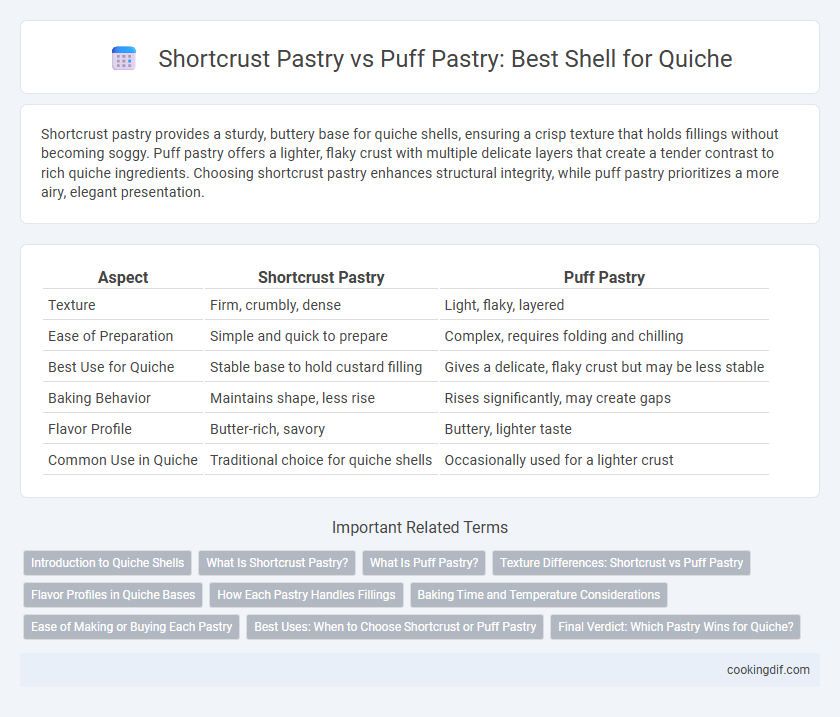Shortcrust pastry provides a sturdy, buttery base for quiche shells, ensuring a crisp texture that holds fillings without becoming soggy. Puff pastry offers a lighter, flaky crust with multiple delicate layers that create a tender contrast to rich quiche ingredients. Choosing shortcrust pastry enhances structural integrity, while puff pastry prioritizes a more airy, elegant presentation.
Table of Comparison
| Aspect | Shortcrust Pastry | Puff Pastry |
|---|---|---|
| Texture | Firm, crumbly, dense | Light, flaky, layered |
| Ease of Preparation | Simple and quick to prepare | Complex, requires folding and chilling |
| Best Use for Quiche | Stable base to hold custard filling | Gives a delicate, flaky crust but may be less stable |
| Baking Behavior | Maintains shape, less rise | Rises significantly, may create gaps |
| Flavor Profile | Butter-rich, savory | Buttery, lighter taste |
| Common Use in Quiche | Traditional choice for quiche shells | Occasionally used for a lighter crust |
Introduction to Quiche Shells
Quiche shells are typically made with either shortcrust pastry or puff pastry, each offering distinct textures and flavors that influence the overall dish. Shortcrust pastry provides a firm, crumbly base that supports moist fillings without becoming soggy, ideal for traditional savory quiches. Puff pastry, with its light, flaky layers, adds a delicate crispness and visual appeal but may not hold up as well to wetter fillings.
What Is Shortcrust Pastry?
Shortcrust pastry is a type of dough known for its crumbly and tender texture, made from a mixture of flour, fat (usually butter), and water, without leavening agents. Unlike puff pastry, which relies on multiple layers of folded dough and butter to create a flaky and airy shell, shortcrust pastry provides a sturdy, crisp base ideal for holding dense fillings like quiche. This pastry's simplicity and firmness make it perfect for savory tarts, delivering a rich, buttery flavor that complements the creamy custard and savory ingredients inside the quiche.
What Is Puff Pastry?
Puff pastry is a flaky, layered dough made by repeatedly folding butter into the dough, creating numerous air pockets that puff up when baked, resulting in a light, crisp texture. Unlike shortcrust pastry, which is crumbly and dense, puff pastry offers a delicate, buttery shell that enhances the quiche's airy filling. Using puff pastry for a quiche shell provides a contrasting texture that balances richness and crispness, ideal for a refined presentation.
Texture Differences: Shortcrust vs Puff Pastry
Shortcrust pastry offers a firm, crumbly texture that provides a sturdy base for quiche, preventing sogginess and supporting heavy fillings. Puff pastry features multiple flaky layers created by folding butter into dough, resulting in a light, airy shell with a crisp bite. The choice between shortcrust and puff pastry significantly affects the quiche's mouthfeel, with shortcrust providing a dense, buttery foundation and puff pastry delivering a delicate, layered crunch.
Flavor Profiles in Quiche Bases
Shortcrust pastry offers a rich, buttery flavor that creates a sturdy, crumbly shell, enhancing the savory filling of a quiche with its tender texture. Puff pastry provides a light, flaky, and layered crust that adds a subtle sweetness and crispness, giving the quiche an airy, delicate bite. Choosing between these bases depends on whether a robust, hearty foundation or a light, flaky contrast is preferred to complement the quiche's creamy, savory custard.
How Each Pastry Handles Fillings
Shortcrust pastry creates a sturdy, crumbly shell ideal for holding dense or wet fillings without becoming soggy, providing a firm texture that supports quiche ingredients like eggs, cheese, and vegetables. Puff pastry's multiple flaky layers offer a lighter, airier base but can become soggy more quickly when exposed to moist fillings, making it best for quiches with drier components or those served immediately after baking. Understanding how shortcrust retains structure versus puff pastry's delicate flakiness ensures optimal texture and filling integration in quiche preparation.
Baking Time and Temperature Considerations
Shortcrust pastry requires baking at a moderate temperature of around 350degF (175degC) for 15-20 minutes, providing a firm and crumbly quiche shell that holds fillings well. Puff pastry demands a higher temperature, approximately 400degF (200degC), with shorter baking times of 12-15 minutes, resulting in a light, flaky texture but with a risk of uneven cooking if the filling needs longer baking. Selecting shortcrust pastry ensures consistent heat retention and a stable base during extended baking, while puff pastry suits quiches with quick-cooking fillings to preserve its delicate layers.
Ease of Making or Buying Each Pastry
Shortcrust pastry is generally easier to make or buy for quiche shells due to its simple ingredients and straightforward preparation, requiring just flour, fat, and water. Puff pastry involves more complex techniques with multiple layers of dough and butter, making it harder to prepare from scratch, though high-quality pre-made options are widely available. Home cooks seeking convenience often prefer shortcrust pastry, while puff pastry offers a flakier texture but demands more skill or reliance on store-bought versions.
Best Uses: When to Choose Shortcrust or Puff Pastry
Shortcrust pastry offers a firm, crumbly texture ideal for savory quiche shells that require stability to hold dense fillings like cheese, vegetables, and meats without becoming soggy. Puff pastry provides a light, flaky, and buttery crust that enhances quiches with delicate, custard-based fillings, delivering an elegant presentation and contrasting texture. Choose shortcrust for a robust, crisp base perfect for hearty quiches, and puff pastry to achieve a more airy, luxurious crust suited for lighter, refined flavor profiles.
Final Verdict: Which Pastry Wins for Quiche?
Shortcrust pastry offers a sturdy, buttery base that holds quiche fillings well, ensuring a crisp texture without becoming soggy. Puff pastry provides a lighter, flaky shell with multiple layers, adding a delicate crunch but may lack the structural support needed for heavier fillings. For classic quiche, shortcrust pastry is preferred due to its durability and ability to complement rich, custard-based fillings effectively.
Shortcrust pastry vs puff pastry for shell Infographic

 cookingdif.com
cookingdif.com